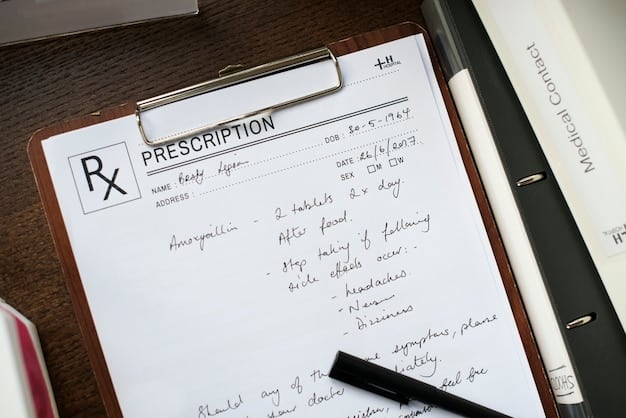Master Healthcare Bill Negotiation: Dispute Errors & Payment Plans

Healthcare bill negotiation involves identifying errors, understanding your insurance coverage, and communicating effectively with healthcare providers and insurers to potentially lower your medical expenses through payment plans or discounts.
Navigating healthcare costs can be daunting, but mastering healthcare bill negotiation: dispute errors and negotiate a payment plan is a crucial skill. This guide will empower you to understand your rights, identify billing errors, and negotiate effectively for fair and manageable payment options.
Understanding Your Healthcare Bill
Before diving into negotiation, it’s essential to comprehend what you’re being billed for. Medical bills can be complex, filled with codes and jargon. Taking the time to decipher your bill is the first step to potential savings.
Decoding Medical Jargon
Medical bills use specific codes to represent treatments, procedures, and diagnoses. Understanding these codes helps you verify the services rendered.
Itemized Billing
Always request an itemized bill. This detailed statement lists each charge individually, allowing you to scrutinize every aspect of the bill, from medication costs to lab fees.

- CPT Codes: These codes describe medical, surgical, and diagnostic procedures.
- ICD Codes: These codes relate to your diagnosis and why you received treatment.
- DRG Codes: Diagnosis Related Group codes are generally used for inpatient services and represent a bundled payment for a range of services.
Understanding the components of your healthcare bill sets the stage for identifying discrepancies and negotiating effectively. By familiarizing yourself with medical jargon, you’ll be better equipped to question any charges that seem inaccurate or unreasonable.
Identifying Errors and Discrepancies
Medical billing errors are more common than you might think. A study by the American Medical Association revealed that a significant percentage of medical bills contain errors. Identifying these errors is crucial for successful healthcare bill negotiation.
Common Billing Errors
Keep an eye out for common billing errors, such as duplicate charges, services not rendered, upcoding (billing for a more expensive service than provided), and incorrect personal information. This information will help you save a lot of money.
Double-Check Everything
Carefully review each line item on your bill. Compare the services listed to the treatment you actually received. Check dates, codes, and descriptions to ensure accuracy.
- Duplicate Charges: Look for the same service listed multiple times.
- Phantom Charges: Charges for services you didn’t receive.
- Upcoding: When a provider bills for a more expensive service than the one you received.
Spotting errors on your medical bill requires diligence and attention to detail. By being proactive and thorough in your review, you can identify mistakes that could save you money on the negotiation process.
Understanding Your Insurance Coverage
Your health insurance plan plays a critical role in determining how much you owe for medical services. Understanding your coverage helps you navigate the billing process and negotiate effectively.
Policy Specifics
Familiarize yourself with your deductible, co-pay, and coinsurance. These costs determine your out-of-pocket expenses.
Network Status
Ensure the provider is in your insurance network. Out-of-network services often incur higher costs, and negotiating these bills may require a different approach.

- Check Your Explanation of Benefits (EOB): This document from your insurance company outlines the services they covered and your remaining balance.
- Understand Your Deductible: Know how much you need to pay before your insurance starts covering costs.
- Verify Co-pays and Coinsurance: Be aware of the fixed amount or percentage you owe for services.
By understanding your health insurance coverage, you can better assess the accuracy of your medical bills and negotiate from an informed position. Knowing your plan details empowers you to challenge incorrect charges and seek fair payment options.
Contacting the Healthcare Provider
Once you’ve identified potential errors or have questions about your bill, the next step is to contact the healthcare provider’s billing department. Effective communication can often resolve billing issues quickly and amicably.
Polite Communication
Speak with the billing department or patient financial services at the hospital or doctor’s office to discuss the bill. Be polite, respectful, and clear about your concerns.
Detailed Explanation
Prepare a list of specific questions or discrepancies you’ve found. Clearly explain what you believe is inaccurate and why.
- Be Professional: Maintain a calm and respectful tone throughout the conversation.
- Document Everything: Keep records of who you spoke with, the date, and the details of your conversation.
- Ask for Clarification: Don’t hesitate to ask for more information or explanation if something isn’t clear.
Directly engaging with the healthcare provider is a critical step in resolving billing discrepancies. By communicating clearly, professionally, and with documented evidence, you can often achieve a more favorable outcome in your healthcare bill negotiation.
Negotiating a Payment Plan
If you’re unable to pay your medical bill in full, negotiating a payment plan can provide a manageable way to settle your debt. Many healthcare providers are willing to work with patients to establish affordable payment arrangements.
Interest Calculation
Request an interest-free payment plan. Many hospitals and clinics are willing to waive interest charges for patients in need. Talk it through to get the best outcome for yourself.
Income and Expenses
Prepare a budget outlining your income and expenses to demonstrate your financial situation. This documentation can help strengthen your case for a reasonable payment plan.
- Negotiate the Amount: See if the provider is willing to reduce the total amount owed.
- Set a Realistic Timeline: Work with the provider to establish a payment schedule that fits your budget.
- Get It in Writing: Always obtain a written agreement outlining the payment plan terms.
Negotiating a payment plan is a practical solution when faced with unaffordable medical bills. By being proactive, transparent, and prepared, you can often secure a payment arrangement that eases your financial burden.
Seeking External Assistance
In some cases, negotiating medical bills can be challenging, and you may need external assistance. Several resources are available to help you navigate the complex world of healthcare costs.
Patient Advocates
Consider hiring a patient advocate. These professionals can review your bills, negotiate with providers, and help you understand your rights.
Non-Profits
Explore non-profit organizations that offer assistance with medical debt. These groups may provide financial aid or negotiation support.
- Medical Billing Advocates: Professionals who specialize in reviewing and negotiating medical bills.
- Consumer Protection Agencies: Government agencies that protect consumers from unfair billing practices.
- Legal Aid Societies: Organizations that provide free or low-cost legal assistance to those in need.
Navigating healthcare bills can be overwhelming, but you don’t have to do it alone. Seeking external assistance from patient advocates, non-profit organizations, or government agencies can provide the support and expertise needed to achieve a fair resolution.
| Key Point | Brief Description |
|---|---|
| 🔎 Check for Errors | Review for duplicate charges and services not received. |
| 🏥 Contact Provider | Politely discuss billing discrepancies with provider’s billing dept. |
| 🗓️ Payment Plan | Negotiate an interest-free payment plan if unable to pay in full. |
| 🤝 Seek Assistance | Consider help from patient advocates or non-profit organizations. |
Frequently Asked Questions
▼
An itemized medical bill provides a detailed breakdown of all charges incurred for medical services, including procedures, medications, and room fees, if applicable. It’s essential for verifying the accuracy of your medical expenses.
▼
Review your bill carefully for duplicate charges, services you didn’t receive, or inflated service costs. Compare the bill with your insurance’s Explanation of Benefits (EOB) for consistency and accuracy.
▼
Contact the healthcare provider’s billing department immediately to dispute the error. Provide detailed information about the discrepancy, and keep a record of your communication and any supporting documents.
▼
Contact the provider to discuss your financial situation and request a payment plan. Be prepared to provide documentation of your income and expenses. Negotiate for interest-free options and a realistic payment schedule.
▼
If you’re facing large, complex bills, struggling to negotiate, or unsure of your rights, consider hiring a patient advocate or seeking assistance from non-profit organizations. They can provide expertise and support in resolving billing issues.
Conclusion
Mastering healthcare bill negotiation is a valuable skill that can save you money and reduce stress. By understanding your healthcare bill, identifying errors, knowing your insurance coverage, communicating effectively, and seeking assistance when needed, you can navigate the complexities of medical billing with confidence.





